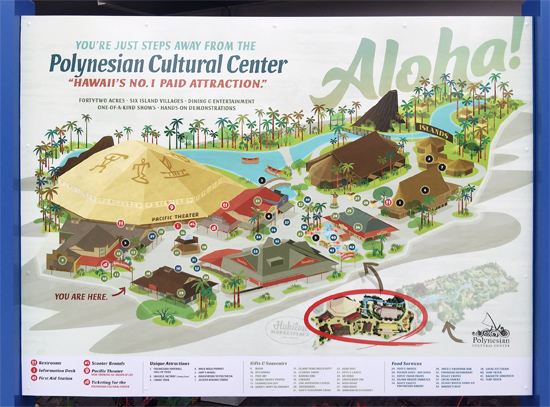
…and still more at the PCC’s new Hukilau Marketplace
PCC’s Hukilau Marketplace is also a great place just to relax and enjoy the old Laie charm. There will often be free entertainment at the Gazebo, several historical statues, even a few of what people in the industry call “gags” — something you’ll find to be fun.
For instance:
A heroic-proportioned statue of the late Hamana Kalili (1882–1958) marks one end of the Marketplace. Kalili, a large, powerful Hawaiian fisherman, originated what is now called the “shaka” sign when he lost three fingers on his right hand in an industrial accident at Kahuku Sugar Mill, leaving only the thumb and little finger. Years later Kalili waved his unique greeting to thousands of tourists as he represented King Kamehameha in the old Laie Hukilau program, that started in 1948 . . . and the sign has since spread around the world. It can mean a lot more than just “hello.” Check it out
A similar statue, yet to be placed, honors a boy from Laie who invented the distinctive gliding sounds of the Hawaiian steel guitar: The late Joseph Kekuku (1874–1932), who went by a shortened form of his long Hawaiian middle name, soon started entertaining on a much broader scale. He left Hawaii in 1904, never to return, and helped popularize Hawaiian music around the world, until he passed away in New Jersey — but his invention is synonymous today with Hawaii music
The PCC commissioned one of its own alumni — Leroy Transfield, a Maori student worker originally from New Zealand who now lives and works in Utah — to sculpt both the Kalili and Kekuku statues.
Ship’s wheels: Kids are welcome to spin our two interactive ship steering wheels, but they actually pay tribute to a miracle that happened nearby about 100 years ago, when the Laie Hawaii Temple was under construction (1916-1918):
At one point construction workers ran out of lumber for cement forms because of World War I supply and shipping problems. Contractor Ralph E. Woolley prayed for divine help, and during a severe storm two days later, a freighter ran hard aground on a reef off Hukilau Beach. Its captain offered the cargo of lumber to the local Latter-day Saints, if they could offload the materials. Skilled Hawaiian watermen jettisoned the lumber, formed rafts, and with the help of the waves, pushed and swam them ashore. The ship floated free on the tide, and construction continued on the Laie Hawaii Temple, which was dedicated on Thanksgiving Day 1919.
Our Holoholo Pidgin phones are “gags.” As thousands of immigrants from Asia and other parts of the world, most speaking their own languages, joined our Hawaiian population in the 19th century, a delightful form of “pidgin” English arose so they could communicate with each other.
Many local people still talk Hawaiian Pidgin today, which uses a lot of English, but also a combination of Hawaiian, Asian and other words wrapped around distinctly Polynesian inflections and grammar . . . so, huh? It might sound familiar, but it’s way different.
Feel free to eavesdrop on our “party-line” telephones to hear a history of old Laie, as its colorfully discussed in Pidgin.
Please note, this is a pass-through exploration of the Hukilau Marketplace. There’s still more to see and experience here . . . when you next join us. Aloha.
Story and pictures by Mike Foley

Mike Foley, who has worked off-and-on
at the Polynesian Cultural Center since
1968, has been a full-time freelance
writer and digital media specialist since
2002, and had a long career in marketing
communications and PR before that. He
learned to speak fluent Samoan as a
Mormon missionary before moving to Laie
in 1967 — still does, and he has traveled
extensively over the years throughout
Polynesia and other Pacific islands. Foley
is mostly retired now, but continues to
contribute to various PCC and other media.

Recent Comments